World War I and The Lord of the Rings: The Trenches of Moria
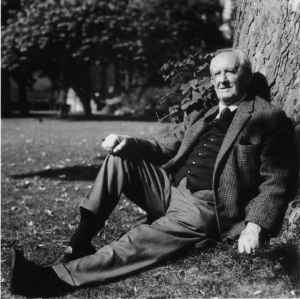
The Lord of the Rings created the very image we have today when we think of the fantasy genre. Many fans find inspiration in a small hobbit’s journey to save all of Middle-Earth. But what if the story of the ring of power is not so clear-cut? Is Frodo destroying The Ring a story of overcoming odds or one of reasserting societal norms? J.R.R. Tolkien started writing about Middle-Earth in the trenches of World War I where is was on the front lines for four months. His British culture and life in The Great War are far more present in The Lord of the Rings than Tolkien would have ever liked to admit. Many place Tolkien’s work as an allegory while Tolkien himself made it very explicit that The Lord of the Rings was by no means an allegory for war. This analysis by no means disagrees with Tolkien’s assertion. The Lord of the Rings is not an allegory for war. However, through the lens of World War I poets, like Wilfred Owen and Siegfried Sassoon, it becomes clear that the trilogy was not left untouched by Tolkien’s experience in war.
J.R.R. Tolkien, Wilfred Owen, and Siegfried Sassoon share similar imagery for two supposedly separate genres. Tolkien uses the same graphic imagery on the Orcs as Wilfred and Sassoon use in their depictions of the atrocities of World War I. However, while Wilfred and Sassoon used these styles to criticize the British government, Tolkien utilizes the same technique to justify mass violence against an entire race in Middle-Earth. This tactic depicts the Orcs as a one-dimensional evil resulting in the fellowship being the clear “good guys”. This kind of similarity continues in the fellowship’s embodiment of Victorian class systems that Tolkien, Owen, and Sassoon experienced through their own immediate instatement as officers due to their higher class status. The fellowship reflects the British military ranking by class in World War I; while the Orcs of Moria and the Orcs throughout the trilogy are the one-dimensional evil that represents a clear and present ‘other’. Only when the fellowship follows the Victorian class paradigm that Sassoon and Owen condemn, are they able to defeat the ‘other’ that embodies the barbaric acts of World War I. Therefore Tolkien’s text suggests the belief that the British hierarchy was the reason Britain claimed victory over the gruesome lack of humanity that was the evil of World War I. The Lord of the Rings then argues for a recede from social progress through a refusal of class mobility ending in any resemblance of a good result.
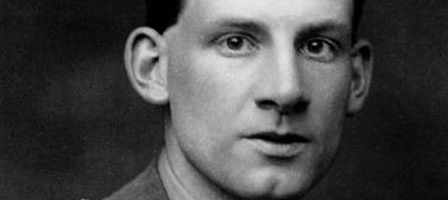
“Memoirs of a Fox-Hunting Man”: The Fellowship as high-class officers
Tolkien is arguing that only those with the divine right to the higher classes can fix the world by ridding it of such violent evils like World War I and Sauron’s armies. If the Orcs accepted their lower status in the hierarchy, the tragedy of the war for Middle-Earth would have never happened. This reinforces the concept of the “Great Chain of Being” in the belief that nobody of lower class, such as an Orc, have the right to try to defy the system. By the end of the trilogy, the fellowship keeps its class system values in its destruction of Sauron’s armies and The Ring. Middle-Earth is rebuilt according to the societal structures Owen, Sassoon, and many others have criticized. The marriage of Aargorn, the King of Man, and Arwen, an Elven princess, cements the old social order into the future of Middle-Earth. Together they reaffirm the hierarchy by restoring the Elves and Men to their rank above the Orcs. Tolkien is then holding onto the class systems Britain firmly had in place at the beginning of the war that Sassoon and Owen also experienced. Sassoon writes of these very issues in his memoirs; which he encountered before going off to war. The following is from Siegfried Sassoon’s Memoirs of a Fox-Hunting Man, a novel that takes experiences from Sassoon’s life and incorporates them into the fictional character, George Sherston. At this point in the novel, George Sherston looks back on his first servant, “…he never allowed me to forget my position as ‘a little gentleman’: he always knew exactly when to become discreetly respectful. In fact, ‘he knew his place’.” (Sassoon 10). At this point in his memoirs he is acknowledging the absolute subservience and loyalty of a man who is in a class beneath him.
Tolkien romanticizes the subservience of George Sherston’s servant through Sam’s unquestioning loyalty to his Master Frodo. This hobbit Master/Servant relationship is a direct reflection of the real class systems that took place in Britain before and at the beginning of World War I. In his memoirs and poetry, Sassoon expresses an eventual disgust with this way of life. Owen and Sassoon blame this class system for the loss of so many British soldiers. To them the upper class were using everyone beneath them to fight their wars. The “Aragorns” of our world were the ones that Owen and Sassoon were protesting against. Instead of going along with this growing progressive ideal that started sweeping through Europe at the time ─ most dramatically beginning with the over throw of the Russian Royal family, the Romanovs, in 1917 ─ Tolkien reverts back to the past instilling the British class systems before the revolutions spread across Europe.
Tolkien strongly forces the audience to empathize with the fellowship. He designs them as the only ones with the power to save Middle-Earth from the Orc invasions. This is in direct opposition to the messages Sassoon and Owen are trying to emote using the same tragic descriptions of violence. Royalty and wealthy land owners make up the company of the fellowship. There are only two possible exceptions to this, the first being Sam the servant.
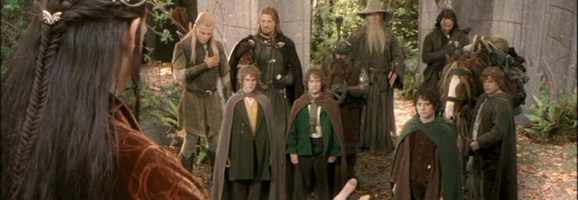
Sam only reinforces the hegemonic powers of the hierarchy through his constant obedience and disregard for his own well-being for his Master Frodo. This no longer makes him a possible exception, but a character who placates to the class systems. The other possible exception is Gandalf. Although he is not a land owner or royalty, he is divinely superior for he is not from the realm of Middle-Earth. He is one of the five wizards sent to Middle-Earth. Wizards in this universe work much like archeangels in Catholicism. Gandalf is sent to specifically help destroy the ring of power and restore the hierarchy. He brings a spiritual aspect of divine right to destroy The Ring. The very ring that could help other groups, such as the Orcs, gain some sense of equality. His adamant support of Aragorn’s right to ascend to the King of Man affirms the belief that one can only be born into a position of power and people like Boromir have no right to try to better their position in life. (Boromir being the son of the Steward of Gondor where Aragorn is supposed to rule. Boromir often argues to use the power of The Ring to fight the Orcs off. His act of grabbing such power is presented in a negative light, implying his move to lead his people is an unordained move). The result of Gandalf, a spiritual being, reinforcing the hierarchy makes him a major influence in how the fellowship functions. If Tolkien were to write this along the lines of the messages of Owen and Sassoon the fellowship would revolt against those with privileged power such as, Gandalf and Elrond (a powerful Elf who possesses one of the three powerful Elven rings distributed by Sauron), for sending them on such a quest. In addition, Sam would in some way become an equal or be ‘promoted’ to a higher position in the fellowship for all of his efforts. This is the exact situation that the officers who gained their positions due to their class status were afraid of from the hard-working lower classes who worked their way up to officer. The fellowship in no way distinguish themselves from such fear as they make no attempts of breaking the social order.
The “Othering” effect on Orcs
The only time in The Fellowship of the Ring the Orcs are physically present is in the Mines of Moria. They appear in large numbers and are in direct conflict with the fellowship, initiating the violence; thus resulting in the Orcs holding resemblance to the evils of World War I that Tolkien experienced along with Owen and Sassoon on the front lines. This instantly designates them as the one-dimensional ‘other’ that the fellowship have to defeat. The fellowship being small in number allows for personalization of the fellowship members, giving the reader knowledge of their names and ranks thereby creating an invested interest in their livelihood.
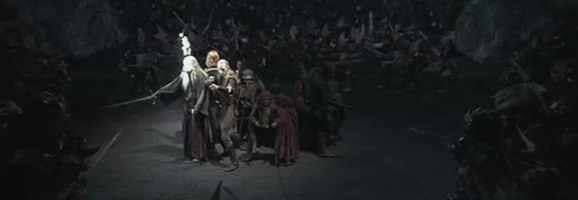
The fellowship and the Orcs relationship mirrors the “Us and Them” mentality in Siegfried Sassoon’s Memoirs of a Fox-Hunting Man. At the time George Sherston enlists in the war there is a clear distinction between the higher class of officers and those who worked to be promoted to the rank of officer. The higher classes’ uniforms distinguished them from officers that were of lower class. Those of lower classes had cheaper yellow shirts and those of the upper crust were able to purchase higher quality material thereby visually representing class status in the midst of war. Those of lower ranks of the British WWI army are referred to as NCOs (Non-Commissioned Officers), they are acknowledged only in large numbers and never given specific titles or names. This created a gap between the classes. Tolkien does not escape this mentality in his fantasy world between the fellowship and the Orcs. The Orcs are designed to be the lower, nameless class like the NCOs and the fellowship embody the personalized higher class officers. Just like how the officers condemned the NCOs’ ability to climb up the social hierarchy to become officers, so does the fellowship oppress the Orcs in their attempt to gain advancement in Middle-Earth. Tolkien is then continually enforcing the Orcs being lesser than the fellowship in a similar way in which he would have observed oppression of lower class NCOs.
Tolkien persists on the dehumanization of the Orcs through the hellish physical mutilation of the race. This is similar to descriptions of the tragic injuries endured by many soldiers in World War I as represented in the poetry by Owen and Sassoon. This only creates a clearer binary of good and evil in the fellowship’s interactions with them: clearly asserting the Orcs as separate from the heroes. The Orcs have been a threat militarily to the fellowship, but in Moria we are introduced to a ‘subspecies’ called the Uruks of Mordor, that are “large and evil” (Tolkien 338).
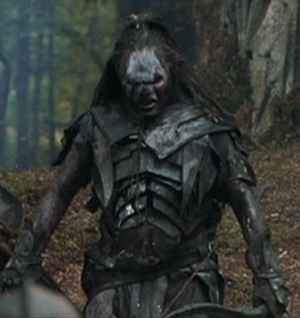
The Uruks are described as “man-high”, as having a “broad flat face,” and eyes like “coal” (Tolkien 339). In contrast from the dark features his “tongue is red”. By saying he is “man-high” disassociates the Uruk from the men making him an ‘other,’ and therefore removing any quality that could have granted the Uruks a characteristic a reader could relate to. As a result this pushes the fellowship closer to the ‘Us’ and the Orcs closer to the ‘other’. The physical description of the Orc’s face and eyes give us a demonic depiction and asserts them as “evil” (Tolkien 338). The Orcs are then repeatedly described in the same way Owen encapsulates the physical harm soldiers underwent in trench warfare. Wilfred Owen in “Dulce Et Decorum Est” focuses on the eyes to emphasize the “all blind” and “eyes withering” to illustrate the effects of gas ─ a new industrial, biological weapon introduced in World War I ─ on his fellow soldiers (Lines 6 & 19). The “incurable sores on innocent tongues” of Owen’s poem are seen in the Orcs in Moria through Tolkien directing particular attention to the red tongue (Line 24). The Orcs are the race that experience the physical consequences of violence unlike the fellowship that remain untainted physically from the violence they engage in with the Orcs in Moria.
Dwarf Mines turned World War I Trenches
The fellowship represents the high-class officers’ first experiences with the mutilated sights of trench warfare in their escape from the depths of Moria. “The Rear-Guard” by Siegfried Sassoon is a poem that incorporates the same experiences as those of the fellowship. His poem is from his own experiences in World War I on the Hindenburg Line in April 1917. The narrator of the poem is “groping along the tunnel” trying to navigate his way along the dark trench labyrinth, much like the fellowship does when they are first trapped in the mines after a sea creature entraps them in the mines (Line 1). As the narrator continues on his dark journey he runs into a dead body. This World War I trench experience motif is in the Mines of Moria, in The Fellowship of the Ring when the fellowship comes upon Balin’s tomb after stumbling through the tunnels and discovering the other remains. They are caught by just as much surprise as the narrator in “The Rear-Guard.” As the narrator is in the tunnel he mentions “muttering creatures underground” (Line 21). These “muttering creatures” can be seen in Moria with the sounds the fellowship hears when Pippin makes a ruckus and alerts the Orcs of their presence. A drumming begins and the Orcs make a stir and become the “muttering creatures.” The fear of the “blackening wound” and mutilation of the body felt by the narrator in “The Rear-Guard” when he finds the body in the trenches is then brought to life in Tolkien’s work with the war injured looking Orcs that are inhuman in their appearance (Line 18). The drums emphasize the sound of a heartbeat feeling heavy as fear crawls through a soldier or a member of the fellowship. Having the Orcs making these noises as a warning of their approach, gives living breath to the fears portrayed in “The Rear-Guard.”
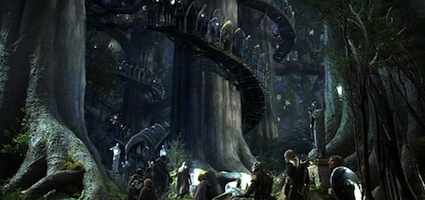
By allowing the fellowship to escape the mines and the Orcs being unable to follow them into the daylight of Lorien, Tolkien sends the message that the Orcs have no natural right to leave the hell-like mines for a better place. The Orcs and the upheaval the fellowship leave behind in Moria are similar to the images the narrator in “The Rear-Guard” encounters when he exits the tunnels. They, like the narrator of “The Rear-Guard,” are “unloading hell behind them” (Line 25). Wilfred Owen’s “Dulce Et Decorum Est” shares in this hell description of trench warfare through the image of fire that repeats itself in the poem with lines like “the haunting flares” and “like a man on fire” (Lines 3 & 12). The fire imagery is accented in the Moria passage with Balrog, a creature that is made of fire and rock. This is the “hell” the fellowship leaves behind them as they fight their way out (Sassoon line 25). By having the fellowship leave this “hell” and go directly to the complete opposite landscape of Lorien. The lands of Lorien are denied to the Orcs and are then indicating a denial of availability to the lower classes. Tolkien asserts the fellowships separation from the dangerous matters of Moria through Lorien. This construes a feeling of detachment from the horrors that Sassoon is trying to face. Instead of the fellowship being altered by their encounters with the Orcs in Moria, they stay above them and unsympathetic towards their enemy. As a result the ‘other’ never gets more than one dimension, implying the Orcs’ inferiority to the fellowship who get to leave the Orcs behind in what are the fantasy trenches or hell-like lair. This is opposite of the messages of breaking class barriers and the blurring of good and evil that Sassoon tries to promote.
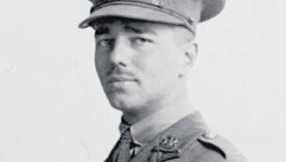
Both share in a hell-like description which in Tolkien’s case makes the Orcs and the Mines of Moria even more evil, perpetuating the binary of good and evil as polarized. Wilfred Owen’s poem “Miners” continues along the lines of Tolkien’s imagery of fire and brimstone in Moria, painting a picture of it being the “hell” they “unload behind them” (Sassoon line 25). The poem is explicitly about miners that died in an explosion in an attempt to dig tunnels under enemy trenches. It already sounds like the dwarves who dug deep into the pits of Moria and unleashed the Balrog, fire and rock itself. Owen brings images of fire, coal, dark pits, embers and burning. It paints a similar picture to the mines of Moria and its depictions of the Orcs “coal” eyes and the “dark pits” full of “fire” and “ember” (Owen 1973). This poem about explosions and comrades lost has the same descriptions as a supposedly escapist piece of fantasy.
What does this mean?
What is truly peculiar about this message is how much is pushes against the ideals that the fandom, specifically the American audience, hold true. The American dream is an ideology that through hard work and perseverance a person can climb the social ladder and make it. Yet the readers accept Tolkien’s message and cheer for Aragorn and Frodo as they reassert their higher class status on those below them. Those unfortunate enough to live in Mordor, a place that does not get sunlight and does not allow for agriculture are the Orcs, who are forced to eat maggoty bread and each other. As an audience we condone the slaughter and mistreatment of thousands of Orcs. We do this through the power of Tolkien defining the Orcs as an ‘other’. This kind of mentality is strong and works today as it did in World War I by justifying violence against the ‘other’ through the supposed good that a classist society upholds.
What do you think? Leave a comment.











Nice read. Tolkien said himself that LotR is no allegory, although that shouldn’t stop us from finding whatever we want in good professor’s books.
Frodo, Sam, Gollum: probably the only characters in LOTR that actually represent soldiers. Frodo, is Sam’s employer. He’s the officer that leads the enlisted men into battle who makes decisions for better or worse and must “bear the burden” of it all. Sam is the enlisted character or the sergeant. He is a loyal servant that never wavers in his loyalty. Gollum is the split personality of a soldier that guides them through No Mans Land. He is childlike and innocent in one hand and manipulative cutthroat killer in the other.
There are some similarities, Tolkien made a lot of WW1 references in the series, but he also based a lot of it around Norse Paganism and Christianity. This is an interesting article though, thanks for the post.
This is not the first, nor the last article that compare Tolkien’s works with historical events. The man’s work lives.
Thanks for this article! An excellent read. Tolkien said something to the effect of cordially disliking allegory in all its manifestations. That being said, traces of all levels of history can find some echo in his work. Especially the medieval! Tolkien was a medievalist and you would be surprised by just how much of Middle Earth found roots in that time. I do agree that it is hard to clearly divorce LOTR from the war; war is very much a present theme in the novels. I also love the ways that you compared it to other contemporaries. Wilfred Owen is one of my all time favorite poets.
Sorry for the rambling nature of my comment, but sleepiness and enthusiasm for Tolkien are hard to contain. Excellent piece!
Intriguing thesis.
So much attributive writing about the distress associations of the LOTR. If Tolkien had desired to explain every reason for his creations in the books’ textual components, he would have accepted the annotation style for doing so. Intriguing? Why would anyone write years after even the award-winning motion pictures about the probabilities that JRR Tolkien had of making allusions and allegories for his original texts?
Because, people need a dose of reality when you start comparing what someone had experienced as real war in relation to what JRR Tolkien and the motion pictures presented as fantastical subjects.
What we have here in LOTR is JRR Tolkien’s clear impressions as to the heroic style, and it might be a little more complex than a story about one prince or hero. An educated p e r s o n might draw several arrows leading from Sam G in “The Fellowship of the Ring.” At least one points to Frodo who is a real hero undergoing a trial (a continuous trial by the way). What make thereof of Sam G? He’s like an anti-hero. Could be pathetic but is largely responsive. Hmmmm! Another arrow points back to his memories from the Shire (va-va boom, baby!).
Enough! Maybe Sam G’s a diminutive allusion or allegory about the myth of Achilles and Patroclus during the Siege of Troy. Patroclus is one of Achilles’ favorite companions with the Myrmidons, yet it is Patroclus, himself, who takes the initiative, however unscrupulous, to stop a serious assault at their beachhead by the Trojans. True, war is the good, the bad, and the ugly. Petroclus had died because of his bravery and impetuous stratagem. To me Petroclus is Sam G to a certain extent. Sam G’s reasons and reaction are not exact, but his impetuousness is.
The ugliness doesn’t stop there. There’s all sorts of wars going on in Middle Earth, one being the Battle of Five Armies. But you don’t see me waiting for our World War I Allied brethren to throw enemy corpses from their trenches back over the side on which they came?
Well, excellent summation at least. The illusion is “Intriguing thesis,” as grant says. What we really require, though, is JRR Tolkien’s exact annotations!
frodo breaks in and exchanges items like a spy or criminal. is it war or is it all about control? maybe we will understand soon
Addressing the final question as to why Americans accept this dominance of the ruling class over the masses seemingly in contradictions of its “hard work and perseverence” values, I submit that America loves an underdog. No one in the story works harder or faces longer odds than the Fellowship. Truly, Frodo’s quest to Mordor represents the ultimate test of perseverence, continuing on his mission in spite of opposition, personal loss, and the ever present temptations offered by Sauron (arguable a Satan figure) through the ring. The allegory of the ring touches on a battle against addiction and/or (more broadly) the temptation to give in to pleasure over purpose – a constant threat to the American pursuit of “the dream.”
Interesting article, however, I feel that you are missing a large part of Tolkien’s motivations for his depictions of Moria, Mordor and the Orcs. Tolkien was an avid lover of nature and grew up in a rural area of England that he adored. He is frequently quoted as being distressed by the rise of industrialisation in the surrounding area, particular those advances which took out swathes of his local wildlife. I do agree that the military and WW1 played a huge role in his formation on the enemy but I think there are more components to his depictions then what was outlined above. Many attributes of the enemy people and lands come from his disgruntled outlook on this industrialising situation, which was further developed from his experiences in the great war.
Frodo, Sam and the other hobbits come from very humble backgrounds, so it seems odd to place them as some kind of “high nobility”. Boromir is shown to be the misled son of a power hungry tyrant, who’s father was gluttonous, greedy, and negligent ruler. Aragorn was a man that did not want power, yet when called upon to fight a genocidal regime he united people of all creeds to put a stop to it. I think you are trying to push a narrative that isn’t there, perhaps you should read the original books in their entirety.
Agreed